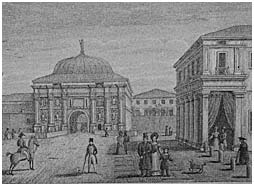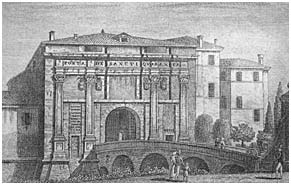| TREVISO FROM 16TH CENTURY TO RESTORATION OF PIAZZA INDIPENDENZA |
| |
1508:

|
Treviso strengthened its defences because it feared a more and more prospective assault:
a) Some quarters, among these the quarters of San Tomaso and San Zeno, were demolished for tactical reasons;
b) Frà Giocondo was instructed to build a new city walls wider than the previous and a canal was made on
the outside town at the foot of the Walls. Two new Gates: Porta San Tomaso and Porta Santi Quaranta were raised
also on this occasion; |
|
| |

Porta San Tomaso - 1846
Engraving by Antonio Nani.
(Biblioteca Comunale di Treviso) |

Porta Santi Quaranta- 1846
Engraving by Antonio Nani.
(Biblioteca Comunale di Treviso) |
|
| |
 |
c) Some medieval towers were pulled down because they had become already useless by the changing of the war strategy. |
| |
|
October 8, 1511:  |
The French and German troops besieged Treviso;
this siege went on only eighth days because the foreign armies understood the storming of the town would
be very difficult. |
| |
|
| 1511: |
The river Piave overflow again its banks inundating also Treviso. |
| |
1513:

|
A new probable assault from German troops appeared again; thus the
monasteries of Santi Quaranta, St. Maria di Gesł, St. Maria Maddalena, St. Maria Mater Domini, the Lazaretto,
other smaller Hospitals, the Churches and the private buildings, which were outside Walls, were demolished because they
might become a shelter for the besiegers. |
| |
|
| 1591: |
Treviso, as many other areas of Italy, was affected by a heavy famine. |
| |
|
| 1607: |
The Chiesa di Santi Quaranta (Church of Forty Saints) was ended. |
| |
|
| |
|
 |
On the left: The bridge of St. Margherita - 1846 - Engraving by Antonio Nani.
(Biblioteca Comunale di Treviso) |
|
| |
|
| 1608: |
The bridge of St. Margherita was built again. |
| |
|
| 1609: |
The Perseveranti Academy was opened; it set itself as goal the diffusion of literature. |
| |
|
| 1631: |
A new pestilence broke out in Treviso, it engendered 1023 dead persons. |
| |
|
| February 25, 1695: |
Treviso was hit by an earthquake, which didn’t cause heavy damages
in the town, but it was very destructive in the hill areas. Two oil lamps were lighted in Duomo (the Cathedral)
and in the Chiesa di Santa Maria Maggiore (Church of St. Maria Maggiore) as a mark of gratefulness for the escaped danger and this fact was
celebrated in St. Costanza Day. |
| |
|
| 1705: |
The Podestà restored the Piazza delle Donne (today called ’Piazza Indipendenza’) at the time.
|
| |
|
| |
GO ON >>> |


